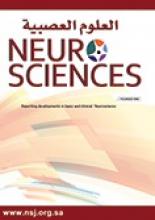Review ArticleReview Article
Open Access
The use of immune modulating drugs for the treatment of multiple sclerosis
Fahd A. Al-Khamis
Neurosciences Journal January 2016, 21 (1) 4-9; DOI: https://doi.org/10.17712/nsj.2016.1.20150252
Fahd A. Al-Khamis
From the Department of Neurology, Faculty of Medicine, Deanship for Scientific Research, University of Dammam, Dammam, Kingdom of Saudi Arabia
MBBS
References
- ↵
- van Kessel K,
- Moss-Morris R
- ↵
- Compston A,
- Coles A
- ↵
- Frohman EM,
- Havrdova E,
- Lublin F,
- Barkhof F,
- Achiron A,
- Sharief MK,
- et al.
- ↵
- Kos D,
- Kerckhofs E,
- Nagels G,
- D’hooghe MB,
- Ilsbroukx S
- ↵
- Schwid SR,
- Covington M,
- Segal BM,
- Goodman AD
- ↵
- Tillema JM,
- Renaud D,
- Mark Keegan B
- ↵
- Fletcher MA,
- Zeng XR,
- Barnes Z,
- Levis S,
- Klimas NG
- ↵
- Viglietta V,
- Baecher-Allan C,
- Weiner HL,
- Hafler DA
- ↵
- Krumbholz M,
- Derfuss T,
- Hohlfeld R,
- Meinl E
- ↵
- Haghikia A,
- Hohlfeld R,
- Gold R,
- Fugger L
- ↵
- Conlon P,
- Oksenberg JR,
- Zhang J,
- Steinman L
- ↵
- Navikas V,
- Link H
- ↵
- Krupp LB
- ↵
- Iaffaldano P,
- Viterbo RG,
- Paolicelli D,
- Lucchese G,
- Portaccio E,
- Goretti B,
- et al.
- ↵
- Mostert S,
- Kesselring J
- ↵
- Romme Christensen J,
- Börnsen L,
- Ratzer R,
- Piehl F,
- Khademi M,
- Olsson T,
- et al.
- ↵
- Kowarik MC,
- Pellkofer HL,
- Cepok S,
- Korn T,
- Kumpfel T,
- Buck D,
- et al.
- ↵
- Sato DK,
- Nakashima I,
- Bar-Or A,
- Misu T,
- Suzuki C,
- Nishiyama S,
- et al.
- ↵
- Rao SP,
- Sancho J,
- Campos-Rivera J,
- Boutin PM,
- Severy PB,
- Weeden T,
- et al.
- ↵
- Turner MJ,
- Lamorte MJ,
- Chretien N,
- Havari E,
- Roberts BL,
- Kaplan JM,
- et al.
- ↵
- Menge T,
- Stüve O,
- Kieseier BC,
- Hartung HP
- ↵
- Coles AJ,
- Compston A
- ↵
- Cohen JA,
- Coles AJ,
- Arnold DL,
- Confavreux C,
- Fox EJ,
- Hartung HP,
- et al.
- ↵
- Maggi E,
- Vultaggio A,
- Matucci A
- ↵
- Ibitoye R,
- Wilkins A
- ↵
- Gross RH,
- Krieger S
- Wiendl H,
- Kieseier B
- ↵
- Costelloe L,
- Jones J,
- Coles A
- ↵
- Kihara Y,
- Groves A,
- Rivera RR,
- Chun J
- Longbrake EE,
- Ramsbottom MJ,
- Cantoni C,
- Ghezzi L,
- Cross AH,
- Piccio L
- ↵
- Spencer CM,
- Crabtree-Hartman EC,
- Lehmann-Horn K,
- Cree BA,
- Zamvil SS
- ↵
- Ghoreschi K,
- Brück J,
- Kellerer C,
- Deng C,
- Peng H,
- Rothfuss O,
- et al.
- ↵
- Linker RA,
- Lee DH,
- Ryan S,
- van Dam AM,
- Conrad R,
- Bista P,
- et al.
- ↵
- Papadopoulou A,
- D’Souza M,
- Kappos L,
- Yaldizli O
- ↵
- Kappos L,
- Gold R,
- Arnold DL,
- Bar-Or A,
- Giovannoni G,
- Selmaj K,
- et al.
- ↵
- Meissner M,
- Valesky EM,
- Kippenberger S,
- Kaufmann R
- ↵
- Polman CH,
- O’Connor PW,
- Havrdova E,
- Hutchinson M,
- Kappos L,
- Miller DH,
- et al.
- ↵
- Warnke C,
- Adams O,
- Hartung HP,
- Kieseier BC
- ↵
- Planas R,
- Jelčić I,
- Schippling S,
- Martin R,
- Sospedra M
- ↵
- Warnke C,
- Pawlita M,
- Dehmel T,
- Posevitz-Fejfar A,
- Hartung HP,
- Wiendl H,
- et al.
- ↵
- Schwab N,
- Schneider-Hohendorf T,
- Posevitz V,
- Breuer J,
- Göbel K,
- Windhagen S,
- et al.
- ↵
- Sievers C,
- Meira M,
- Hoffmann F,
- Fontoura P,
- Kappos L,
- Lindberg RL
- ↵
- Muñoz-Culla M,
- Irizar H,
- Castillo-Triviño T,
- Sáenz-Cuesta M,
- Sepúlveda L,
- Lopetegi I,
- et al.
- ↵
- Benkert TF,
- Dietz L,
- Hartmann EM,
- Leich E,
- Rosenwald A,
- Serfling E,
- et al.
- ↵
- Kappos L,
- Radue EW,
- O’Connor P,
- Polman C,
- Hohlfeld R,
- Calabresi P,
- et al.
- ↵
- Cohen JA,
- Barkhof F,
- Comi G,
- Hartung HP,
- Khatri BO,
- Montalban X,
- et al.
In this issue
The use of immune modulating drugs for the treatment of multiple sclerosis
Fahd A. Al-Khamis
Neurosciences Journal Jan 2016, 21 (1) 4-9; DOI: 10.17712/nsj.2016.1.20150252
Jump to section
Related Articles
- No related articles found.
Cited By...
- No citing articles found.





